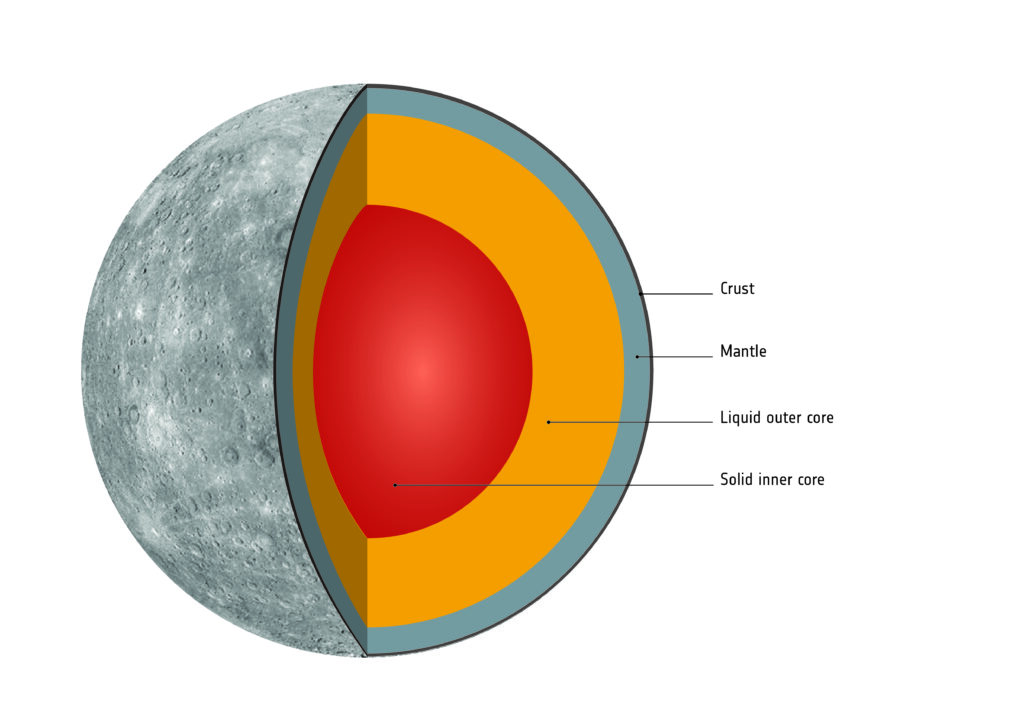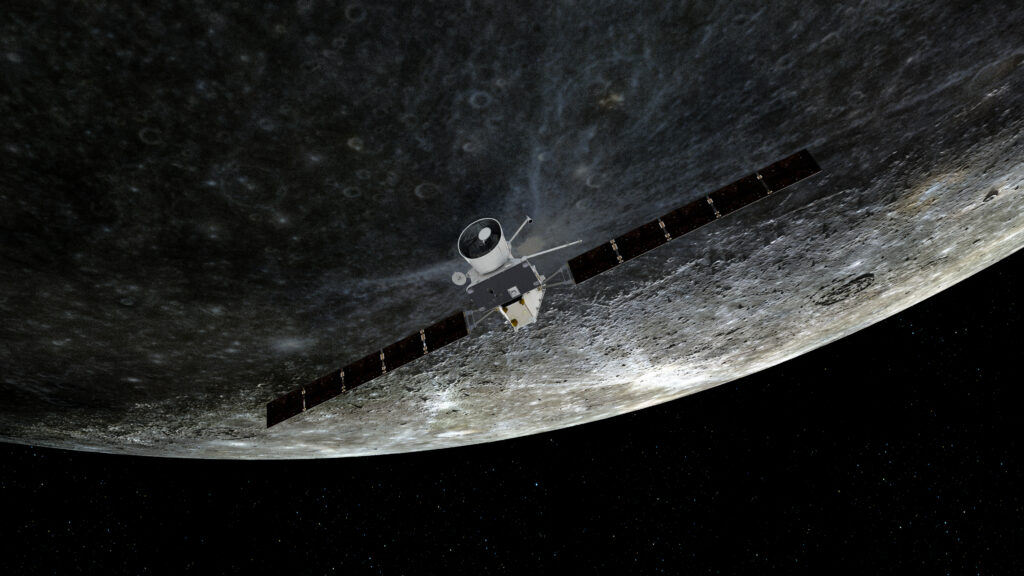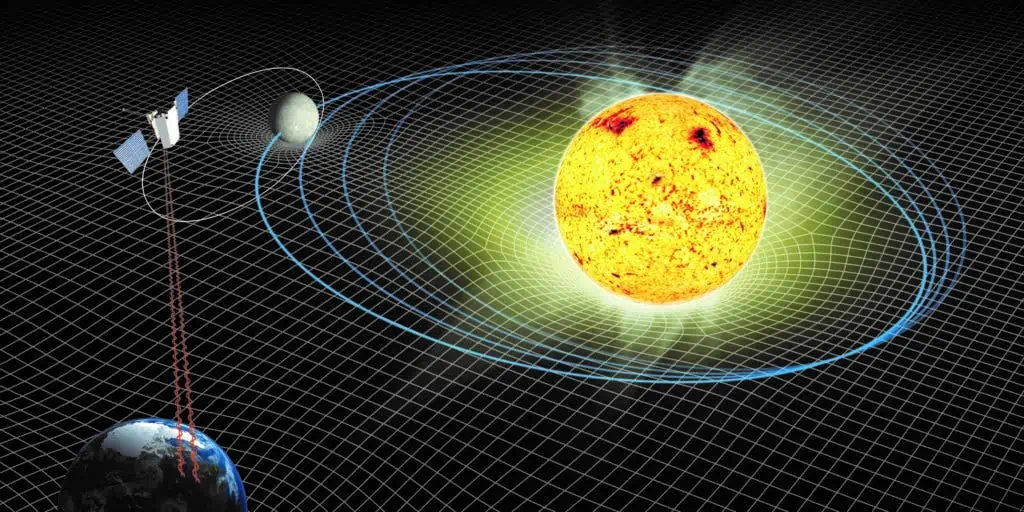The Innermost Planet of the Solar System
© NASA/Johns Hopkins University Applied Physics Laboratory/Carnegie Institution of Washington
Mercury, the innermost planet of our Solar System, is smaller than Jupiter‘s moon Ganymede and Saturn‘s moon Titan. It maintains its proximity to the Sun due to its average orbital distance of 58 million km (36 million miles), resulting in the shortest year of all the planets (an orbital period of 88 days) and exposure to the most intense solar radiation.
Despite its small size (with a mean diameter of 4,880 km or 3,030 mi, about 38% of Earth’s), Mercury possesses a density that affords it nearly the same surface gravity as Mars. The planet hosts a dynamic magnetic field about 1% as strong as Earth’s, and it lacks natural satellites.
Mercury’s surface is marked by ancient, cratered terrains that show no signs of recent geologic activity. Surprisingly, it boasts a magnetic field, which typically indicates a molten core capable of driving surface changes. Given its close proximity to the Sun, surface temperatures on Mercury soar to 430 degrees Celsius (800 degrees Fahrenheit). Remarkably, like our Moon, water ice is found within permanently shadowed craters at the poles.
Viewed from Earth, Mercury remains close to the horizon, never straying more than about 28° angular distance from the Sun. It takes approximately 116 days for successive elongations, when Mercury returns to the same point relative to the Sun in either the morning or evening sky. This period is known as Mercury’s synodic period. Its low position on the horizon also means that Mercury is always observed through a greater portion of Earth’s turbulent atmosphere, resulting in a somewhat blurred view.
Studying Mercury with space probes presents challenges. Its location deep within the Sun’s gravity well requires a significant amount of energy to maneuver a spacecraft from Earth’s orbit to Mercury’s, in a manner allowing it to either orbit the planet or land on it. The first spacecraft to visit Mercury, Mariner 10, conducted three brief flybys of the planet in 1974–75 while in orbit around the Sun.
Subsequent missions, like the U.S. Messenger spacecraft launched in 2004, employed complex routes utilizing gravity assists from repeated flybys of Venus and Mercury over several years. In the Messenger mission, after conducting observations from moderate distances during planetary flybys in 2008 and 2009, the spacecraft settled into an elongated orbit around Mercury for close-up investigations in 2011. Additionally, extreme heat, not only from the Sun but also reradiated from Mercury itself, posed a challenge to spacecraft designers in keeping instruments cool enough to operate.
ABOUT THE PLANET – MERCURY
Mercury is one of four terrestrial planets in the Solar System, and is a rocky body like Earth. It is the smallest planet in the Solar System, with an equatorial radius of 2,439.7 kilometers (1,516.0 mi). Mercury is also smaller—albeit more massive—than the largest natural satellites in the Solar System, Ganymede and Titan. Mercury consists of approximately 70% metallic and 30% silicate material.
INTERNAL STRUCTURE

Mercury is one of the four terrestrial planets in the Solar System, sharing a rocky composition with Earth. It holds the distinction of being the smallest planet, with an equatorial radius of 2,439.7 kilometers (1,516.0 mi). Mercury is smaller in size but more massive than the largest natural satellites in the Solar System, namely Ganymede and Titan. Comprising about 70% metallic and 30% silicate material, Mercury’s inner structure consists of a solid silicate crust and mantle overlying a solid, iron sulfide outer core layer, a deeper liquid core layer, and a solid inner core.
Its density is the second highest in the Solar System at 5.427 g/cm3, only slightly less than Earth’s density of 5.515 g/cm3. Adjusting for gravitational compression, Mercury’s materials would be denser than those of Earth, with an uncompressed density of 5.3 g/cm3 versus Earth’s 4.4 g/cm3.
Mercury’s core stands out for its notably higher iron content compared to other major planets in the Solar System. The prevailing hypothesis suggests that Mercury initially possessed a metal–silicate ratio akin to common chondrite meteorites, representing the standard rocky matter of the Solar System. At that time, Mercury may have experienced a collision with a planetesimal approximately 1/6 of Mercury’s mass and several thousand kilometers in size. This impact could have stripped away much of the original crust and mantle, leaving behind the core as a significantly prominent component. A similar process, known as the giant impact hypothesis, has been posited to elucidate the Moon’s formation.
SURFACE

The surface of Mercury closely resembles that of the Moon, displaying vast plains akin to lunar maria and bearing numerous craters, suggesting long-term geological dormancy spanning billions of years. Unlike Mars or the Moon, Mercury’s surface is notably diverse, lacking extensive regions of uniform geology like maria and plateaus.
The Messenger spacecraft utilized X-ray fluorescence spectra to analyze the composition of Mercury’s surface. It found a high ratio of magnesium to silicon and low ratios of aluminium and calcium to silicon, showing that the crust was not rich in feldspar like the Moon. Crystallization of minerals and convective overturn resulted in the layered, chemically heterogeneous crust with large-scale variations in chemical composition observed on the surface. The crust is low in iron and titanium but high in sulfur (about 20 times richer than the surfaces of Earth, the Moon, and Mars), resulting from the stronger early chemically reducing conditions that are found in the other terrestrial planets.
The surface is dominated by iron-poor pyroxene and olivine, as represented by enstatite and forsterite, respectively, along with sodium-rich plagioclase and minerals of mixed magnesium, calcium, and iron-sulfide. The less reflective regions of the crust are high in carbon, most likely in the form of graphite. The planet’s mantle is chemically heterogeneous, suggesting the planet went through a magma ocean phase early in its history.
Mercury appears to have originated in an environment with significantly lower oxygen levels compared to other terrestrial planets.
NASA states that Mercury is an unsuitable environment for Earth-like life. Its atmosphere consists of a thin exosphere at the surface instead of a structured atmosphere, and it experiences extreme temperatures along with intense solar radiation. These harsh conditions make it improbable for any life forms to survive. While certain subsurface regions of Mercury may have been potentially habitable in the past, and it’s conceivable that primitive microorganisms might have existed there, this remains speculative.
IMPACT CRATERS
The most common topographic features on Mercury are the craters that cover much of its surface. Mercury was heavily bombarded by comets and asteroids during and shortly following its formation 4.6 billion years ago, as well as during a possibly separate subsequent episode called the Late Heavy Bombardment that ended 3.8 billion years ago.
Mercury received impacts over its entire surface during this period of intense crater formation, facilitated by the lack of any atmosphere to slow impactors down. During this time Mercury was volcanically active; basins were filled with magma, producing smooth plains similar to the maria found on the Moon. One of the most unusual craters is Apollodorus, or “the Spider”, which hosts a series of radiating troughs extending outwards from its impact site.
Craters on Mercury exceed 100 km (60 miles) in diameter and start to exhibit features indicative of the transition to the characteristic “bull’s-eye” shape seen in the largest impact basins. These latter formations, known as multiring basins, measure 300 km (200 miles) or more in diameter and are the result of the most powerful impacts.
CALORIS
The Caloris impact basin boasts ramparts spanning approximately 1,550 km (960 miles) in diameter. Its interior is characterized by smooth plains marked with extensive radial and concentric ridges and fractures. The most substantial ridges are a few hundred kilometers long, about 3 km (2 miles) wide, and stand at less than 300 meters (1,000 feet) in height. Over 200 fractures, comparable in size to the ridges, radiate from the center of Caloris, with many appearing as depressions bounded by faults (known as grabens). In instances where grabens intersect with ridges, they typically cut through them, suggesting that the grabens formed after the ridges.
The impact that gave rise to the Caloris Basin was of such magnitude that it led to volcanic eruptions, resulting in a concentric, mountainous ring approximately 2 km tall encircling the impact crater. The floor of the Caloris Basin is filled by a geologically distinct flat plain, broken up by ridges and fractures in a roughly polygonal pattern. It is not clear whether they are volcanic lava flows induced by the impact or a large sheet of impact melt.
PLAINS
Plains, characterized by relatively level or gently undulating surfaces, are widespread features found on Mercury and other terrestrial planets. The process of resurfacing, which involves the covering or smoothing out of rugged terrain to create a more even surface, is responsible for the formation of these plains.
Mercury exhibits two distinct types of plains. The first is the gently rolling, hilly plains located between craters, representing the planet’s oldest visible surfaces that predate the heavily cratered areas. These inter-crater plains seem to have erased many earlier craters and display a scarcity of smaller craters measuring below approximately 30 km in diameter. The second type is the smooth plains, which are expansive, flat regions filling depressions of various sizes and bear a striking resemblance to the lunar maria. Unlike the lunar maria, Mercury’s smooth plains share the same reflectivity as the older inter-crater plains.
SCARPS
One of the most significant landforms on Mercury, offering valuable insights into the otherwise concealed internal processes of the planet, is its numerous lobate scarps. When viewed from above, they exhibit curved or scalloped edges, giving rise to the term “lobate.” These cliffs vary from tens to over a thousand kilometers in length and from about 100 meters (300 feet) to 3 km (2 miles) in altitude. They were formed from fracturing, or faulting when one portion of the surface was thrust up and overrode the adjacent terrain.
On Earth, such thrust faults are limited in extent and result from local horizontal compressive forces in the crust. On Mercury, however, these features range across all of the surfaces imaged so far, implying that Mercury’s crust must have contracted globally in the past. Based on the counts and configurations of the lobate scarps, it seems that the planet experienced a reduction in diameter of up to 7 km (4 miles).
VOLCANOES
Evidence suggests pyroclastic flows occurred on Mercury from low-profile shield volcanoes. A total of 51 pyroclastic deposits have been identified, with 90% located within impact craters. An analysis of the impact craters hosting these deposits indicates that pyroclastic activity took place over an extended period. In the southwest rim of the Caloris Basin lies a “rimless depression” housing a minimum of nine interconnected volcanic vents, with diameters reaching up to 8 km. Consequently, this geological feature is categorized as a “compound volcano”.
CHARACTERISTICS
| MASS | 0.3302 x 1024 kg |
| VOLUME | 6.083 x 1010 km3 |
| SURFACE AREA | 7.48×107 km2 |
| MEAN RADIUS | 2439.7 km |
| SURFACE PRESSURE | ≲ 0.5 nPa |
| DENSITY | 5.427 g/cm3 |
| ESCAPE VELOCITY | 4.3 km/s |
| SURFACE GRAVITY | 3.7 m/s2 |
| ABSOLUTE MAGNITUDE | -0.42 |
| NATURAL SATELLITES | 0 |
| RINGS | NO |
| MEAN TEMPERATURE | 167°C |
| SEMI-MAJOR AXIS | 57,910,000 km |
| ORBIT PERIOD | 115.88 days |
| PERIHELION | 46,001,200 km |
| APHELION | 69,816,900 km |
| MEAN ORBITAL VELOCITY | 47.87 km/s |
| MAXIMUM ORBITAL VELOCITY | 58.98 km/s |
| MINIMUM ORBITAL VELOCITY | 38.86 km/s |
| ORBIT INCLINATION | 7.00° |
| ORBIT ECCENTRICITY | 0.2056 |
| SIDEREAL ROTATION PERIOD | 1407.6 hours |
| LENGTH OF DAY | 59 days |
| MINIMUM DISTANCE FROM EARTH | 77,300,000 km |
| MAXIMUM DISTANCE FROM EARTH | 221,900,000 km |
| MAXIMUM VISUAL MAGNITUDE | -1.9 |
ORBIT AND ROTATION

Mercury’s orbit is unique among the planets, with an inclination of approximately 7° from the ecliptic, the plane defined by Earth’s orbit around the Sun. Additionally, Mercury’s orbit is the most elongated, resulting in the Sun appearing more than twice as bright when the planet is closest (at perihelion, 46 million km or 29 million miles) compared to when it’s farthest (at aphelion, nearly 70 million km or 43 million miles). A Mercurian day, based on the stars, lasts 58.6 Earth days, causing the Sun to move gradually westward in Mercury’s sky.
Mercury completes one orbit around the Sun at an average distance of approximately 57.9 million kilometers (36 million miles) and takes about 88 Earth days to do so. Its axial tilt is nearly zero, with a measured value as low as 0.027 degrees. In comparison, Jupiter has the second smallest axial tilt among all planets at 3.1 degrees. This means that at Mercury’s poles, the center of the Sun never rises more than 2.1 arcminutes above the horizon.
Certain points on Mercury’s surface afford an observer the ability to witness the Sun ascend slightly over two-thirds of the way above the horizon, reverse its course, and set before rising again, all within a single Mercurian day. This phenomenon occurs because, approximately four Earth days before perihelion, Mercury’s orbital velocity matches its rotational velocity, momentarily halting the Sun’s apparent motion.
Closer to perihelion, Mercury’s orbital velocity surpasses its rotational velocity, causing the Sun to appear to move in a retrograde direction. Four Earth days after perihelion, the Sun resumes its normal motion. If Mercury were in synchronous rotation, a similar effect would occur due to the alternating gain and loss of rotation over revolution, resulting in a libration of 23.65° in longitude.
Mercury reaches inferior conjunction (its closest approach to Earth) roughly every 116 Earth days on average, although this interval can vary between 105 and 129 days due to the planet’s eccentric orbit. Mercury’s closest approach to Earth can be as near as 82,200,000 km (0.549 astronomical units; 51.1 million miles), and this proximity is gradually diminishing. The subsequent approach within 82,100,000 km (51 million mi) is projected for 2679, followed by one within 82,000,000 km (51 million mi) in 4487.
However, it won’t be nearer to Earth than 80,000,000 km (50 million mi) until 28,622. The duration of Mercury’s retrograde motion, as seen from Earth, can vary between 8 to 15 days on either side of inferior conjunction, a wide range due to the planet’s high orbital eccentricity. Overall, because Mercury is closest to the Sun on average over time, it is typically the closest planet to Earth and to each of the other planets in the Solar System.
ATMOSPHERE

A planet as small and hot as Mercury lacks the capability to retain a significant atmosphere, even if it once possessed one. Surface temperatures on Mercury range from 100 to 700 K (−173 to 427 °C; −280 to 800 °F) at the most extreme locations: 0°N, 0°W, or 180°W. Near the poles, where there is no atmosphere, temperatures never exceed 180 K. Mercury’s surface pressure is less than one trillionth of Earth’s. Nevertheless, traces of atmospheric components offer insights into intriguing planetary processes.
Mercury, with its weak magnetic field, small mass, and close proximity to the Sun, hosts a very sparse and variable atmosphere, referred to as a surface-bound exosphere. This exosphere contains hydrogen, helium, oxygen, sodium, calcium, potassium, and water vapor, with a combined pressure of about 10−14 bar (1 nPa). These exospheric species originate either from the Solar wind or from the planetary crust. Solar radiation exerts pressure on the atmospheric gases, creating a comet-like tail behind the planet, which is prominently visible in the spectral emission lines of sodium.
While the measured quantities of sodium and potassium are exceedingly low, ranging from hundreds to a few tens of thousands of atoms per cubic centimeter near the surface, telescopic spectral instruments are highly sensitive to these elements. As a result, astronomers can observe denser patches of these gases traversing Mercury’s disk and its vicinity in space. The origin and movement of these gases were initially of theoretical interest, but in the early 1990s, Earth-based radar made a remarkable discovery of highly radar-reflective patches at the poles, later determined to be composed of water ice. Despite Mercury’s proximity to the Sun, the water ice survives by being shielded in permanently shadowed regions of deep near-polar craters.
The notion of the planet closest to the Sun potentially harboring significant deposits of water ice initially seemed improbable. However, over its history, Mercury has accumulated water, most likely from impacting comets and asteroids. On Mercury’s searing surface, water ice instantly sublimates, with individual water molecules following random ballistic trajectories.
MAGNETIC FIELD

Mercury’s magnetic field is distorted by the solar wind, which compresses the magnetic field on the dayside and stretches it out to form a long tail on the night side. Interaction between the solar wind and the planetary field creates the bow shock and magnetopause boundaries, as well as features noted in the figure.
Despite its small size and a rotation period of 59 days, Mercury possesses a substantial and seemingly global magnetic field. According to measurements obtained by Mariner 10, it is roughly 1.1% as strong as Earth’s. At Mercury’s equator, the magnetic field strength is approximately 300 nT. Similar to Earth’s, Mercury’s magnetic field exhibits a dipolar configuration. In contrast to Earth, Mercury’s poles are nearly in alignment with the planet’s axis of rotation.
During MESSENGER’s second encounter with the planet on October 6, 2008, it was observed that Mercury’s magnetic field can exhibit significant “leakage”. The spacecraft encountered magnetic “tornadoes” – coiled formations of magnetic fields linking the planetary magnetic field to interplanetary space – with widths of up to 800 km, equivalent to roughly one-third of the planet’s radius. These twisted magnetic flux tubes, technically known as flux transfer events, form open windows in the planet’s magnetic shield through which the solar wind may enter and directly impact Mercury’s surface via magnetic reconnection.
GRAVITY

The smallest and innermost planet of our solar system has a gravitational force significantly weaker than that of Earth. Its surface gravity is approximately 3.7 meters per second squared (m/s^2), which is about 38% of the gravitational acceleration on Earth. This means that a person weighing 100 kilograms on Earth would weigh only about 38 kilograms on Mercury.
The reason for the planet’s lower gravity lies in its smaller size and mass compared to Earth. With a diameter of about 4,880 kilometers (3,032 miles) and a mass roughly 38% that of Earth, Mercury’s gravitational pull is much less pronounced.
Due to its weaker gravity, Mercury presents unique challenges and opportunities for potential future human exploration. On the one hand, moving around on Mercury would require significantly less effort compared to Earth. Astronauts would be able to jump higher and cover greater distances with much less force. However, the lower gravity could also have potential health implications for humans over extended periods, as it might lead to muscle and bone density loss, similar to what astronauts experience on the International Space Station.
Additionally, the weaker gravity on Mercury affects its atmosphere. Unlike Earth, which has a substantial atmosphere, Mercury’s atmosphere is extremely thin. The low gravity makes it difficult for the planet to retain a substantial atmosphere, and what little atmosphere it has is constantly being stripped away by solar winds.
Understanding Mercury’s gravity is crucial for planning and executing missions to this intriguing planet. It informs spacecraft trajectories, landing procedures, and the design of equipment that will be used on the planet’s surface.
Next Planet – “Venus“
